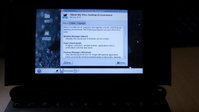ShleeDragon
Pro-Catflip
- Joined
- Aug 28, 2010
- Messages
- 1,749
Because .next should be replacing the older OSes. Id like to discuss any of the plans for a user experience standard.
Id like to see support the following. 1L/1R buttons used as a mouse button in desktop. and normal button in game. The right nub as button thing doesn't always work.
The standard keyboard/number keys and function keys should be kept standard without any addtional trigger.
The Start/Select can be used per application.
The Pandora should be used 1) quick press for ingame options 2) long press for Pandora options.
I think the space button should be a standard ingame options button too.
Pandora options should take following. Toggle wifi/nubmodes/Minimise game/quit game/force-quit game.
The OS should be kept on the NAND and should be kept seperate from the content stored on SD. The OS can be wiped and everything should work as expected with settings/saves.
The SD cards should be mounted as usual. the PNDs mounting and storing all dynamic content on the folders stored on the SD cards.
Any additional/shared content should not be stored in an applications dynamic folders. eg: mame roms can used with multiple PND enabled ports. panmame/mame4pandora/mameex should request the default rom location on first boot and store the path to the roms in settings instead of looking for a hardcoded location on a single PND appdata.
Id like to see support the following. 1L/1R buttons used as a mouse button in desktop. and normal button in game. The right nub as button thing doesn't always work.
The standard keyboard/number keys and function keys should be kept standard without any addtional trigger.
The Start/Select can be used per application.
The Pandora should be used 1) quick press for ingame options 2) long press for Pandora options.
I think the space button should be a standard ingame options button too.
Pandora options should take following. Toggle wifi/nubmodes/Minimise game/quit game/force-quit game.
The OS should be kept on the NAND and should be kept seperate from the content stored on SD. The OS can be wiped and everything should work as expected with settings/saves.
The SD cards should be mounted as usual. the PNDs mounting and storing all dynamic content on the folders stored on the SD cards.
Any additional/shared content should not be stored in an applications dynamic folders. eg: mame roms can used with multiple PND enabled ports. panmame/mame4pandora/mameex should request the default rom location on first boot and store the path to the roms in settings instead of looking for a hardcoded location on a single PND appdata.
Last edited by a moderator:


